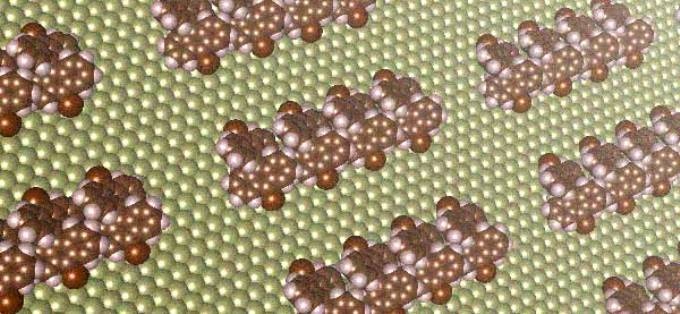Feb 15 2017
 This is a formation of chain-shaped structures on a copper surface from molecular self-assembly, as predicted by a new computational method. These chain-shaped structures can function as tiny wires with diameters 1/100,000th of a piece of hair for future electrical devices. Credit: Kyoto University iCeMS
This is a formation of chain-shaped structures on a copper surface from molecular self-assembly, as predicted by a new computational method. These chain-shaped structures can function as tiny wires with diameters 1/100,000th of a piece of hair for future electrical devices. Credit: Kyoto University iCeMS
The control of nanomaterial fabrication could be improved with a new computational method.
Daniel Packwood, Junior Associate Professor at Kyoto University’s Institute for Integrated Cell-Material Sciences (iCeMS), is improving methods for constructing small “nanomaterials” using a “bottom-up” approach known as “molecular self-assembly”.
This method is used to choose molecules based on their capability to interact and combine to form shapes with particular functions. In the future, this method could be used to develop small wires with diameters 1/100,000th that of a piece of hair, or small electrical circuits that can be placed on the tip of a needle.
Molecular self-assembly is considered to be a spontaneous process that has to be controlled indirectly as it cannot be directly controlled by laboratory equipment. This is carried out by cautiously selecting the direction of the intermolecular interactions, called “chemical control”, and carefully choosing the temperature at which these interactions take place, known as “entropic control”.
Researchers are aware that when entropic control is extremely weak, for example, molecules happen to be under control and also gather in the direction of the free sites available for molecule-to-molecule interaction. It has also been observed that self-assembly does not take place when entropic control is increasingly stronger than the chemical control, and the molecules continue to be randomly dispersed.
Until now, researchers have not been able to guess what types of structures will result from molecular self-assembly when entropic control is neither strong nor weak compared to chemical control.
Packwood collaborated with colleagues in Japan and the U.S. to come up with a computational method that permits them to simulate molecular self-assembly on metal surfaces while simultaneously separating the effects of entropic and chemical controls.
Artificial intelligence has been used by this new computational method in order to simulate how molecules act when placed on a metal surface. A “machine learning” technique is specifically used to examine database of intermolecular interactions.
This technique builds a model capable of encoding the information present in the database, and the outcome of the molecular self-assembly process will be predicted in turn by the model with increased accuracy.
This method was used by the team to study the self-assembly of three different hydrocarbon molecules, whose structures differ in the strength of the direction of their intermolecular interactions. In other words, the strength of chemical control was varied by changing the molecule under study.
Stronger chemical control allowed the molecules to gather into chain-shaped structures, and at the same time effects of stronger entropic controls were discovered to be more counterintuitive. For example, the researches studied that strengthening entropic control could result in transforming large, disordered structures into a number of small, chain-shaped, ordered structures.
The researchers also demonstrated that the arrangement of disordered structures results from weak chemical control and not from strong entropic control.
The researchers verified these predictions by comparing them with high-resolution microscopic images of real molecules on metal surfaces. These predictions can further lead to large-scale, controlled fabrication of small electrical wires and other nanomaterials for future devices. Devices developed from nanomaterials would be considerably cheaper and smaller than existing electronics, and would also have majorly extended battery lives due to low energy consumption.
“By continued development of our code and theory, we expect to obtain increasingly detailed rules for controlling molecular self-assembly and aiding the bottom-up nanomaterials fabrication process,” the researchers conclude in their study published in the Nature Communications.